The First National Bank Of Raton
The First National Bank Of Raton in New Mexico printed $1,347,340 dollars worth of national currency. Over $1,000,000 face value is a lot of money. However, some types and denominations of currency from this bank could still be rare. This national bank opened in 1892 and stopped printing money in 1926, which equals a 35 year printing period. That is a fairly normal lifespan for a national bank. During its life, The First National Bank Of Raton issued 9 different types and denominations of national currency. We have examples of the types listed below. Your bank note should look similar. Just the bank name will be different. For the record, The First National Bank Of Raton was located in Colfax County. It was assigned charter number 4734.
We buy all national currency. Please call or email us for a quote. Sales@AntiqueMoney.com
The First National Bank Of Raton in New Mexico issued 5,680 sheets of $5 1902 territorial blue seal national bank notes. That printing range is high enough to allow for a couple of survivors, but not much more. It may or may not come as a shock, but there are only a half dozen five dollar 1902 blue seal territorial notes currently known to exist. That small number is a direct result of small printing numbers. Only nine banks in the entire country even issued the $5 blue seal as a territorial. One in Alaska, two in Hawaii, two in Arizona, and four in New Mexico. Each note has a portrait of Benjamin Harrison on the left hand side of the bill. If you want to know the exact output of total blue seal territorial $5 bills for this bank then you can just take the number of sheets printed and multiply that number by four. Each sheet had four five dollar bills on it. Not sure if yours is a territorial or a state issue? Just look below the bank’s title. Written in a slightly curved text will be the name of the state the bank was in. If the word Ter or Territorial is before the name of the state then you have a territorial. Territorials are of course more valuable than regular issue state notes.
1902 $5 Blue Seal Territorial National Bank Note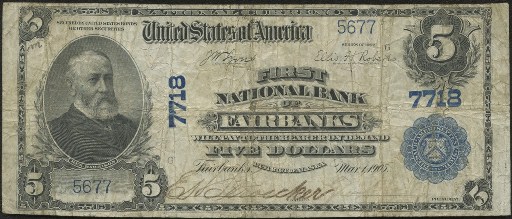
The First National Bank Of Raton printed 3,868 sheets of $10 1902 territorial blue seal national bank notes. Many territorial banks had outputs in the 2,000 to 4,000 range. Common isn’t the right word, but the ten dollar bill is the most “available” denomination of 1902 blue seal territorial notes. There are currently around 30 1902 $10 blue seals known to exist from all territories. You can take the number of sheets printed for this bank, and multiply that by three to get the exact number of $10 notes printed for this type. Each note of course has the portrait of William McKinley on the left hand side. The charter number and overprint are both in blue ink. The number below McKinley is the serial number as it relates to the bank (and it is usually very low). The serial number in the upper right is the treasury serial number which is normally about six digits long. Typically when collectors hear territorial blue seal we think about New Mexico and Arizona. Both of those states printed such notes until each became a state in 1912. However, we also have to remember that all blue seals printed by Hawaii, Alaska, and Porto Rico fit the bill as well since all of their issues were of course issued before statehood.
1902 $10 Blue Seal Territorial National Bank Note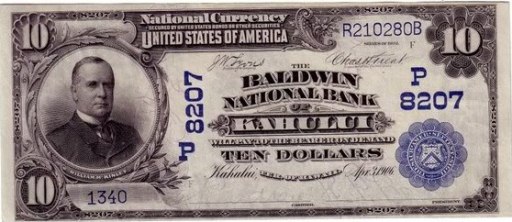
The First National Bank Of Raton also printed 3,868 sheets of $20 1902 territorial blue seal national bank notes. As is the case with all large size twenty dollar national bank notes, the number of sheets printed is the same as the number of individual notes printed. Right now there are about a dozen 1902 $20 territorial blue seals known to exist from all banks in the country. That is not many to go around, but this is still a small hobby. Most collectors who need one probably have one. However, there is still room for these to be very valuable based on their serial number and condition. Just like non-territorials, these also have a picture of Hugh McCulloch on the front of them. These are still good for the face value of $20 today; we definitely don’t recommend spending them though.
1902 $20 Blue Seal Territorial National Bank Note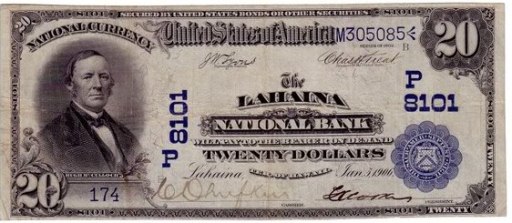
The First National Bank Of Raton also printed 3,032 sheets of $5 1882 territorial blue seal national bank notes. Many territorial banks had outputs in the 2,000 to 4,000 range. All large size five dollar national bank notes were printed on a sheet with four notes per sheet. So you can take the sheet number and multiply it by four to get the total number of bank notes issued for 1882 $5 blue seal territorials. Right now there are over 30 of these notes known to exist. Most of that number is made up of notes from Honolulu. Only eight banks in the country even issued this type. The design looks similar to the earlier 1882 brown backs. James Garfield is on the left hand side of the note. Instead of a brown overprint, 1882 date backs have a blue seal. The back of each note says “1882 – 1908” and that is where the nickname “date back” originates.
1882 Blue Seal $5 Territorial National Bank Note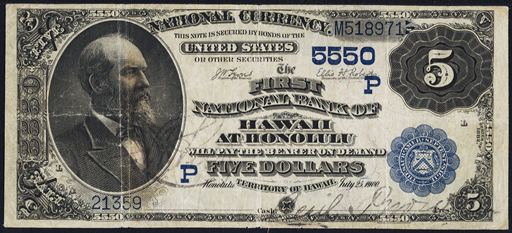
The First National Bank Of Raton also printed 2,215 sheets of $10 1882 territorial blue seal national bank notes. Many territorial banks had outputs in the 2,000 to 4,000 range. You can take that sheet number and multiply it by three to get the exact number of 1882 $10 territorial date backs issued by this bank. Only sixteen different banks even printed this exotic issue. The reason for such a low output has to do with timing. 1882 date backs were not issued until 1908. The only places that were still in territorial status at the time were New Mexico, Arizona, Alaska, and Hawaii. Furthermore, to even qualify to issue these notes the bank had to have been opened between 1888 and 1901. You can see why only sixteen banks ended up printing ten dollar bills like this. Most people who aren’t collectors aren’t entirely sure if they have a territorial or not because non-territorials look exactly the same. Just look below the bank’s title. If it says Territory or Ter before the name of the state, then you have a territorial.
1882 Blue Seal $10 Territorial National Bank Note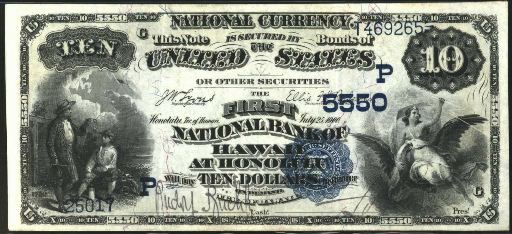
The First National Bank Of Raton also printed 2,215 sheets of $20 1882 territorial blue seal national bank notes. There was just one twenty dollar bill on each sheet of bank notes. So the sheet number is the same as the individual note output. Currently there are about a dozen 1882 $20 blue seals known to exist. Most of that total is from Hawaii, but Arizona, Alaska, and New Mexico each have single examples to represent the state (or in this case, territory). The design of these notes is just like any other 1882 $20 date back. The left hand side of the note has a man pointing a rifle. The right hand side shows lady liberty or Columbia holding a flag.
1882 Blue Seal $20 Territorial National Bank Note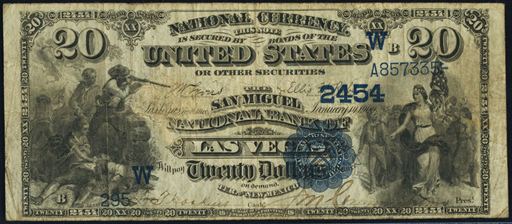
The First National Bank Of Raton also printed 16,400 sheets of $5 1902 blue seal national bank notes. Once a bank prints more than 10,000 sheets of blue seals it becomes very difficult for those notes to be rare. Ben Harrison is on the front of all 1902 $5 blue seal bank notes. This happens to be the smallest denomination issued for the 1902 series. Each note is complete with a blue seal and blue charter number. Despite saying series of 1902, these were actually issued by national banks between 1908 and 1928. There are two different types of blue seals. The first type is called a date back and it has “1902-1908” written on the back of the bill. The other type is called a plain back; it does not have the date stamps on the back of the bill. The values for these notes range widely based on condition and the bank of issue.
1902 $5 Blue Seal National Bank Note
The First National Bank Of Raton also printed 10,819 sheets of $10 1902 blue seal national bank notes. Once a bank prints more than 10,000 sheets of blue seals it becomes very difficult for those notes to be rare. 1902 $10 blue seal bank notes all have a portrait of William McKinley on them. Values can range from as little as $40 up to over $10,000. There really is no trick to know what is rare and what is common by just doing an internet search. You really need to work with an expert (like us) in order to determine the value of your specific bank note. There are at least ten different factors than can make some 1902 $10 blue seals worth more than others. We know exactly what to look for and we would be happy to provide a free appraisal and our best offer.
1902 $10 Blue Seal National Bank Note
The First National Bank Of Raton also printed 10,819 sheets of $20 1902 blue seal national bank notes. The same rarity rules for 1902 $10 blue seals also apply to $20 blue seals. Just remember that $20 bills are by nature three times rarer (unfortunately they don’t command a premium over other denominations). Hugh McCulloch is pictured on the front of each bill. Contact us if you need pricing help.
1902 $20 Blue Seal National Bank Note



